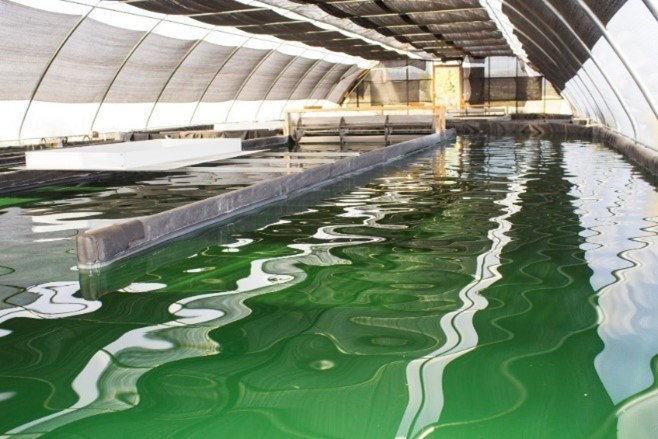Algae and Cyanobacteria are among some of the oldest organisms on the planet and contribute around 70% of the air we breathe from micro-organisms found primarily in the ocean. Cyanobacteria, although not a “true plant” is a form of bacteria that is able to use chlorophyll to absorb light from the sun and produce energy from photosynthesis. Cyanobacteria and algae have been cultivated by humans for centuries, from the Aztecs in central America to communities of Southeast Asia.
Nick’s farm Apogee Spirulina, located in Santa Fe NM where he sells his spirulina at the local farmers market and online. Spirulina may be small in size but the little organism is jam packed with an amazing amount of nutrients, minerals, and protein. Apogee Spirulina is the only Good Agricultural Practices (GAP) certified producer of Spirulina in the US which Nick happily mentioned, he also mentioned that the USDA has recognized spirulina as a food not just a supplement. Spirulina being recognized as a food may help open doors for prospective farmers to pursue spirulina or microalgae operations of their own.
Apogee Spirulina consists of two greenhouses known as Hoop houses which are simple covered frames intended for summer growing season. The interior of the greenhouse consists of one large and two small raceway ponds. A raceway pond is a simple construction pond that looks like an oval raceway, with a paddle wheel creating a “flow” moving the water which allows the culture to increase in density compared to being grown in standing water. Greenhouses allow Nick to capture the heat from the sun and helps retain the moisture from evaporation that would otherwise be lost to an open-air pond. Spirulina may be a photosynthetic organism but direct sunlight can stress the cells and inhibit the culture slowing the growth rate and increasing time between harvests. Nick studied under the Federation of Spirulina farmers France and learned methods that have been practiced for years without the additions of pest or herbicides.
When Nick is ready to harvest his spirulina, he turns the paddle wheel motor off, and waits a day for the spirulina to rise to the surface then he harvests what he needs. Collecting the spirulina Nick uses a cheese cloth to squeeze out the remaining water, then makes his spirulina spaghetti strings. Similar to a baker piping frosting on a cake, Nick uses the same technique to pipe the spirulina into strings. The strings help retain the nutrients in the Spirulina as it dries locking in the vitamins, minerals, protein, essential amino and fatty acids. Once the strings are dry Nick breaks them up and creates his sprinkles. During the peak of the growing season Nick can harvest his spirulina daily depending on how well the culture is growing, and the water collected during harvest is recycled back into the ponds. When the growing season is done Nick retains one raceway of spirulina as inoculant “seed” for the next season.
Spirulina is a nutrient packed micro-organism that can help our bodies receive the right amount of daily nutrients if eaten on a regular basis. There is great information about the nutritional value of spirulina on Apogee’s website showing the vitamin, mineral, amino and fatty acid that a daily dose of Spirulina can offer. One source I found that had a good list of benefits for people adding spirulina to their regular diet is Medical News Today, mentioned the benefits for eye health when eating either spirulina or chlorella. Spirulina is a great supplement for gym rats and active people with a good array of nutrients and vitamins that help the body recover after a workout. Spirulina is packed with protein containing around 60%, a long list of vitamins, along with essential amino and fatty acids. Spirulina could be a healthy addition or alternative to help people who live at or below the poverty line by offering food with real nutritional value compared to highly processed food. Kids who receive school lunches would benefit greatly from the addition of spirulina to their diet, giving their growing bodies a great boost from the nutrients and vitamins spirulina offers.
Nick has tapped into a niche market especially here in NM that allows him to offer a quality product with so many good benefits to human health. Apogee farms strengthens the agricultural system in our state and opens the doors for more diverse small-scale agroecosystems. Small family owned and operated farms increase our food sovereignty, security and strengthen the system by adding layers which ultimately increases resilience. The more diversified the crops being grown in NM and around the Nation strengthens food security since it opens up the discussion on what sustainable agricultural system looks like. Nick is one of the pioneers of a changing agricultural landscape as local farmers embrace practices that allow us to reconnect with the earth.
-Posted by Zach





